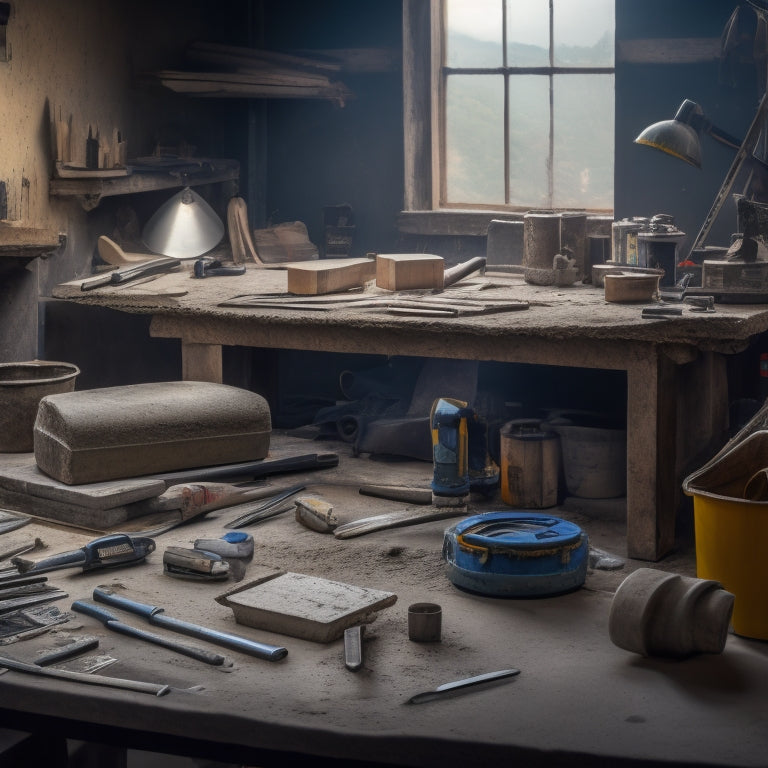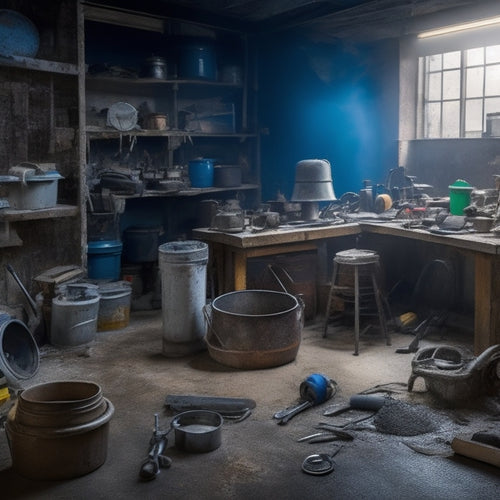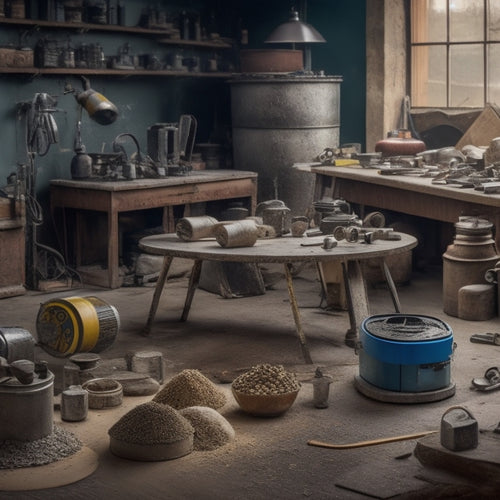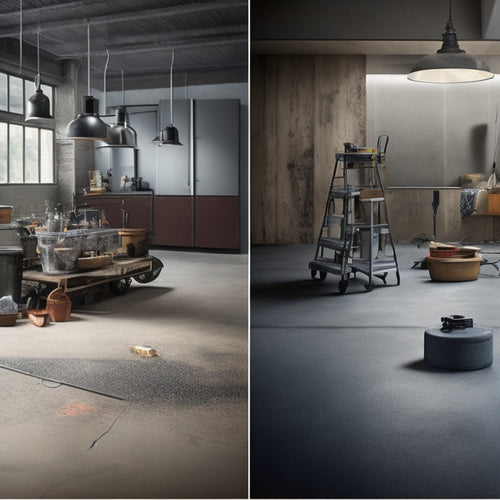
3 Best Hand Tools for DIY Concrete Construction
Share
When tackling a DIY concrete construction project, you'll need three essential hand tools to achieve a professional-looking finish: a mixing stick or paddle for efficient mixing and air pocket elimination, a float trowel for applying a smooth, even finish, and a form bender for creating curved or angled walls. These tools will help you achieve a consistent, high-quality result. By mastering these tools and techniques, you'll be well on your way to creating a stunning concrete structure that meets your design vision - and there's more to explore to take your skills to the next level.
Key Takeaways
• A sturdy mixing bucket or drum is essential for efficient mixing and minimizing contamination risk in DIY concrete construction.
• A mixing trowel or shovel is necessary for scooping, mixing, and pouring concrete easily and effectively.
• A mixing stick or paddle helps break down aggregate and eliminate air pockets for a smooth finish in concrete construction.
• A float trowel is a must-have for applying a smooth, even finish to the concrete surface and removing small imperfections.
• Regular tool maintenance, including cleaning and inspection, is crucial to prevent rust and damage to DIY concrete construction hand tools.
Essential Concrete Mixing Tools
When preparing to mix concrete, you'll need a set of reliable tools to guarantee a consistent, high-quality blend that meets your project's specifications. A sturdy mixing bucket or drum is fundamental, as it allows for efficient mixing and minimizes the risk of contamination. A mixing trowel or shovel is also essential, as it enables you to scoop, mix, and pour the concrete with ease. To achieve a smooth, consistent finish, you'll need a mixing stick or paddle, which helps to break down aggregate and eliminates air pockets.
Proper tool maintenance is imperative to ensure the longevity of your tools and the quality of your mix. Regularly clean and inspect your tools to prevent rust and damage.
Additionally, develop effective mixing techniques to optimize your tool usage. For instance, start by adding the dry ingredients to the mixing bucket, followed by the wet ingredients. Mix in a circular motion, gradually increasing the speed and intensity as the mixture thickens.
Wall Forming and Shaping Tools
You'll need a set of specialized tools to form and shape your concrete walls with precision, including wall form liners, form ties, and a variety of finishing tools. These formwork accessories are essential in achieving the desired shape and texture of your concrete walls. Wall form liners, for instance, help create a smooth, even surface, while form ties guarantee the formwork remains stable and secure.
To achieve the desired shape, you'll need to utilize various shaping techniques. This may involve using specialized tools like form benders, which allow you to create curved or angled walls. You may also need to use wall form brackets to hold the formwork in place as you pour the concrete.
In addition to these tools, you'll need to take into account the type of concrete you're working with and the specific requirements of your project. By selecting the right tools and employing the correct shaping techniques, you'll be able to create strong, durable walls that meet your design specifications.
With the right tools and techniques, you'll be able to achieve professional-looking results, even as a DIY concrete constructor.
Finishing and Smoothing Tools
Finishing and Smoothing Tools
Once you've poured the concrete and allowed it to set, it's time to focus on finishing and smoothing the surface to achieve the desired texture and appearance. This stage is vital, as it determines the final look and feel of your concrete construction.
To achieve a smooth, even finish, you'll need the right tools. Here are some important finishing and smoothing tools you should consider:
| Tool | Description |
|---|---|
| Float Trowel | Used for applying a smooth, even finish to the concrete surface. |
| Finishing Trowel | Ideal for creating a high-gloss finish and removing small imperfections. |
| Edger | Used to create a clean, defined edge along the perimeter of the concrete surface. |
| Tamping Tool | Helps to compact and smooth out the concrete surface, removing air pockets and imperfections. |
When it comes to smoothing techniques, it's important to work in small sections, using gentle, even strokes to achieve a consistent finish. Remember to always work in a well-ventilated area, and wear protective gear to avoid injury. By mastering the art of finishing and smoothing, you'll be able to achieve professional-looking results that will elevate your DIY concrete construction projects.
Frequently Asked Questions
Can I Use Hand Tools for Large-Scale Concrete Construction Projects?
You'll find hand tools sufficient for small-scale projects, but as project scalability increases, efficiency suffers; for large-scale concrete construction, you'll need to supplement hand tools with power tools or heavy machinery to maintain productivity and meet deadlines.
How Do I Properly Clean and Maintain My Concrete Hand Tools?
You'll prolong your concrete hand tools' lifespan by cleaning them thoroughly after each use, storing them in a dry place, and applying rust prevention measures like oil or silicone sprays to prevent corrosion.
Are Concrete Hand Tools Suitable for Other Masonry Projects?
You think your concrete hand tools are one-trick ponies? Think again! You'll be surprised to find they're actually versatile tools suitable for various masonry projects, from bricklaying to plastering, thanks to their compatibility with different materials.
Can I Rent Concrete Hand Tools Instead of Buying Them?
You can explore cost-effective options by renting concrete hand tools instead of buying them, utilizing rental services that offer a wide range of tools, allowing you to access the equipment you need without a significant upfront investment.
What Safety Precautions Should I Take When Using Concrete Hand Tools?
When using concrete hand tools, you must prioritize tool safety and personal protection by wearing gloves, safety glasses, and a dust mask to prevent injuries from flying debris, hazardous materials, and tool malfunctions.
Conclusion
As you wrap up your DIY concrete construction project, it's likely you've come to realize that having the right tools made all the difference.
Coincidentally, the three hand tools we highlighted - the mixing stick, form pins, and trowel - are the same ones professionals swear by.
It's no surprise, given their ability to simplify tasks, guarantee accuracy, and produce a polished finish.
With these essentials in your toolbox, you'll be well-equipped to tackle even the most ambitious concrete projects.
Related Posts
-

7 Tools to Fix Damaged Concrete Floors
You're about to tackle that damaged concrete floor, and the right tools are essential for a successful repair. Start ...
-

Top DIY Concrete Grinding and Polishing Tools
When selecting DIY concrete grinding and polishing tools, you'll want to take into account a range of factors to guar...
-

Top Tools for Revamping Old Concrete Floors
You'll need a range of tools to revamp your old concrete floor, starting with epoxy, acrylic, or polyurethane paint, ...


